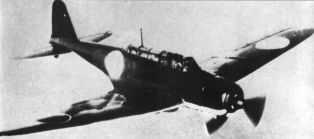Nakajima B5N Kate
JNAF Torpedo Bomber
By Stephen Sherman, Dec. 2009. Updated January 26, 2012.
At the outbreak of WWII, Japan possessed the finest carrier-based torpedo bomber in the world. In the attack on Pearl Harbor, over 100 Kates took place and contributed to the success of the mission by doing heavy damage to U.S. battleships.
Armed with the deadly Type 95 torpedo, the Kate continued to be used successfully in the first half of the war. Kates fatally damaged the USS Hornet, Lexington, and Yorktown.
As American airpower grew, however, the plane showed itself to be terribly underarmed and underpowered. With no armor or self-sealing tanks, it was an easy plane to shoot down. Without fighter escort, the Kate was a sitting duck. They were gradually replaced by the B6N Tenzan, though some Kates continued to see service late in the war. In 1945, like most other Japanese planes, they were converted to kamikaze use.
Type: Torpedo bomber
Introduced: 1938
Japanese Designation: Type 97
Length: 34 ft.
Wingspan: 48.8 ft.
Crew: 2-3
Weight Empty: 4,830 lbs.
Weight Loaded: 8,360 lbs.
Power Plant: One 1.000 hp. aircooled radial.
Armament: One 7.7mm machine gun.
Ordnance: One torpedo or 1,650 pounds of bombs
Top Speed: 235 mph
Range: 634 miles, with drop tanks: 1238 miles
Ceiling: 25,200 ft.
Climb Rate: 1,550 ft./min.
Maneuverability: Fair
Firepower: Poor
Durability: Poor
Source: Defunct Geocities website, Air War Over the Pacific

